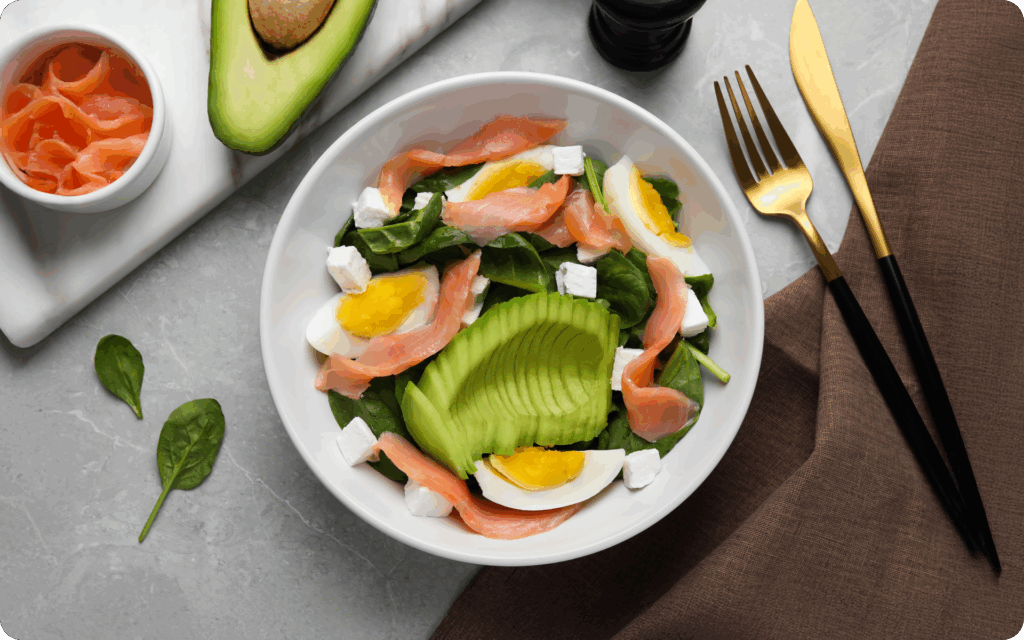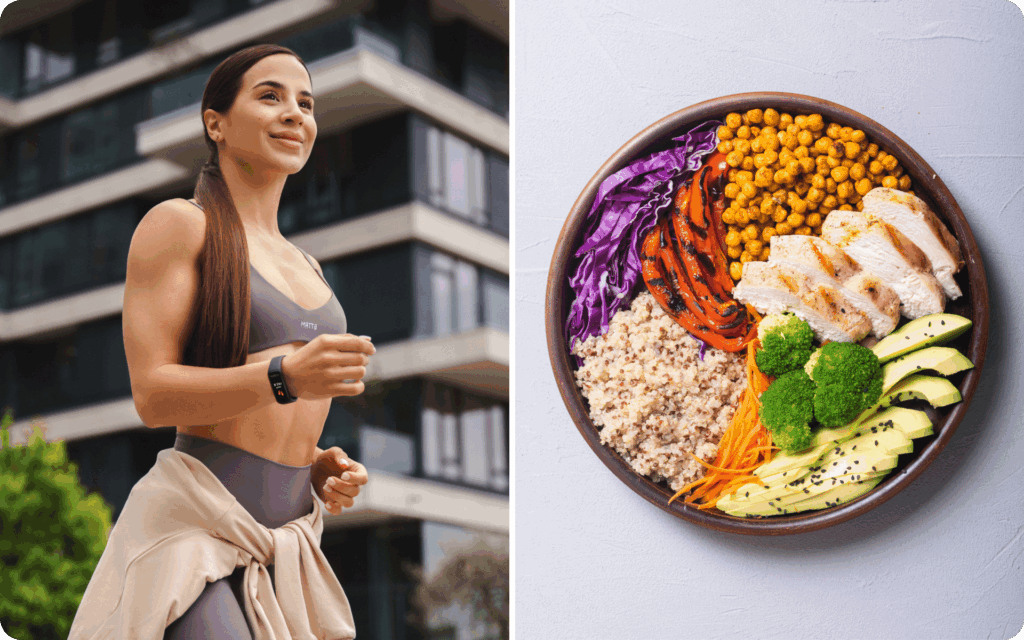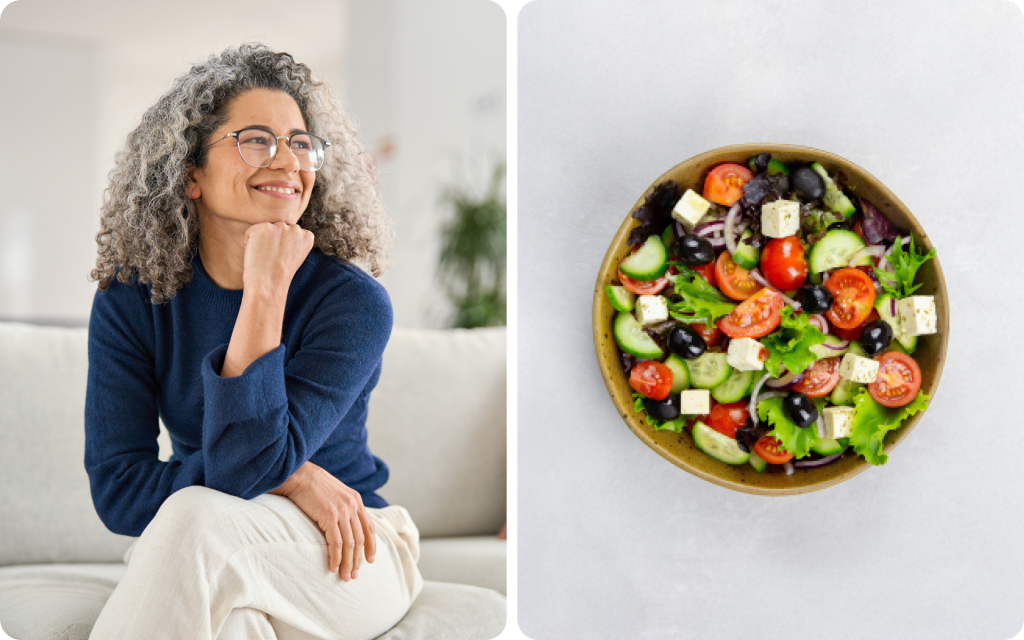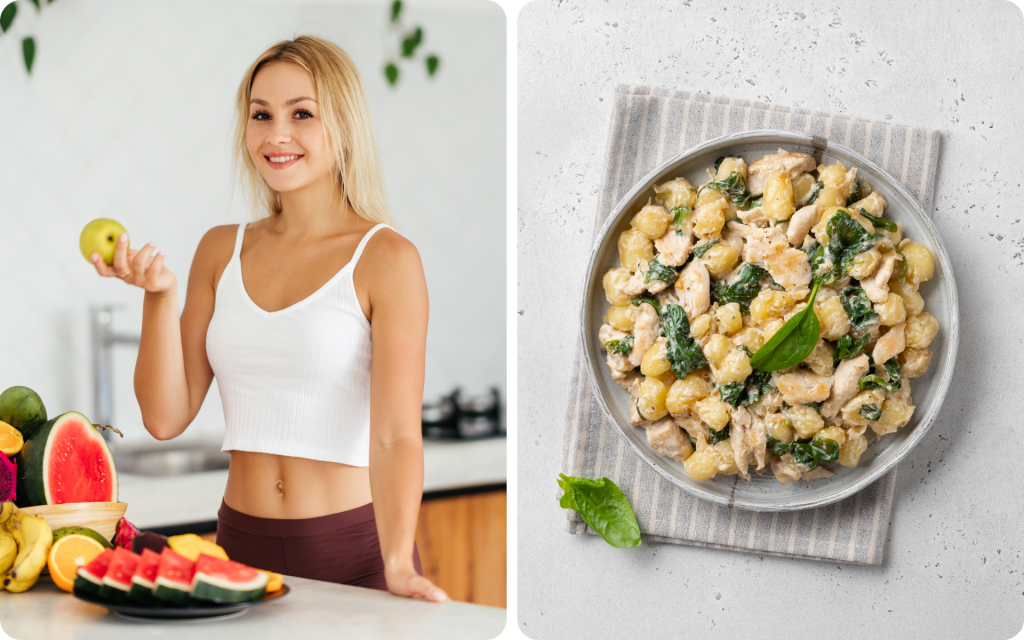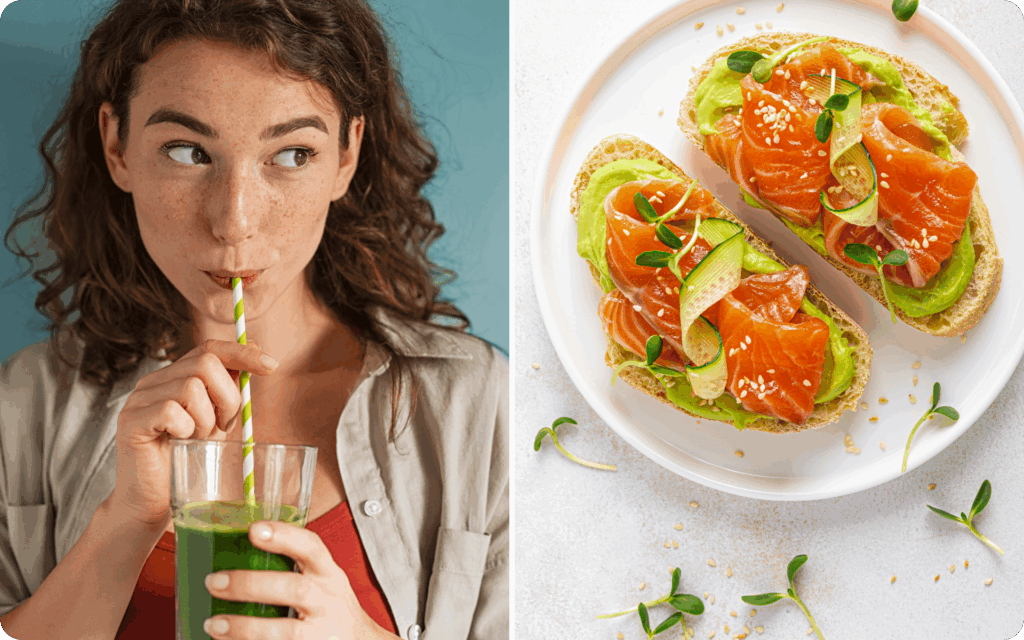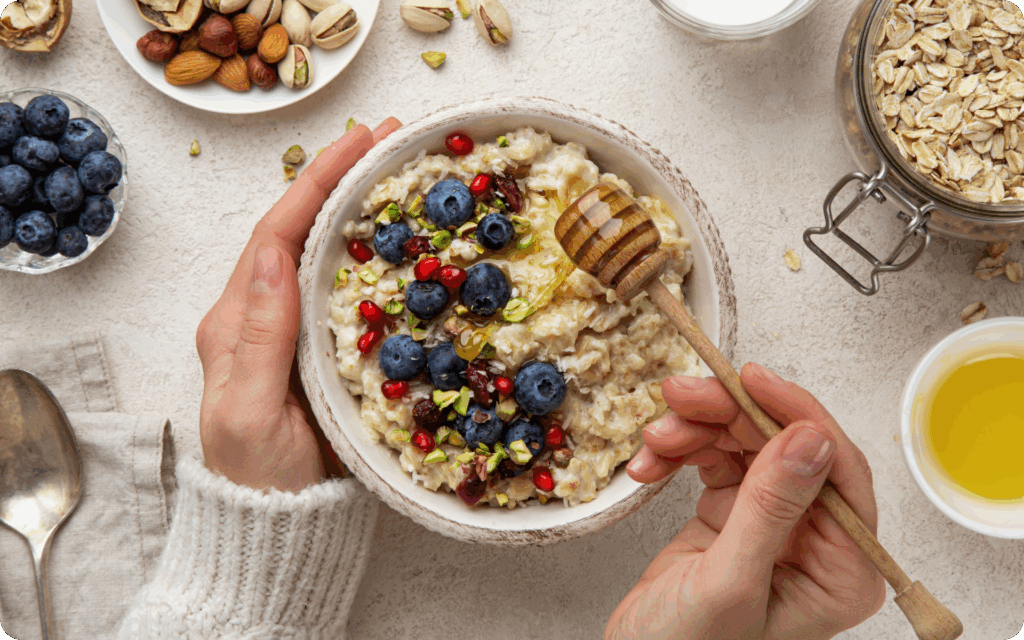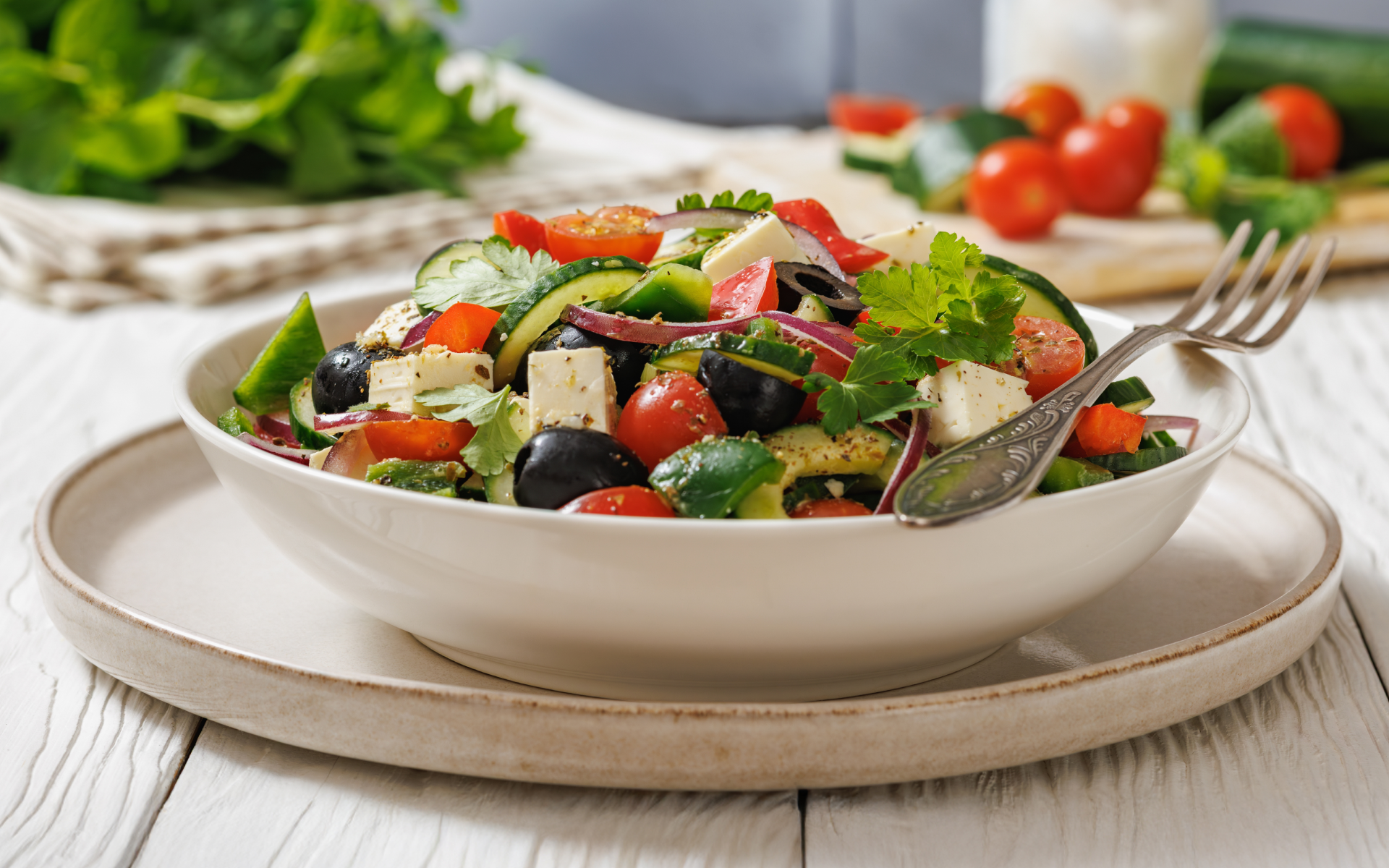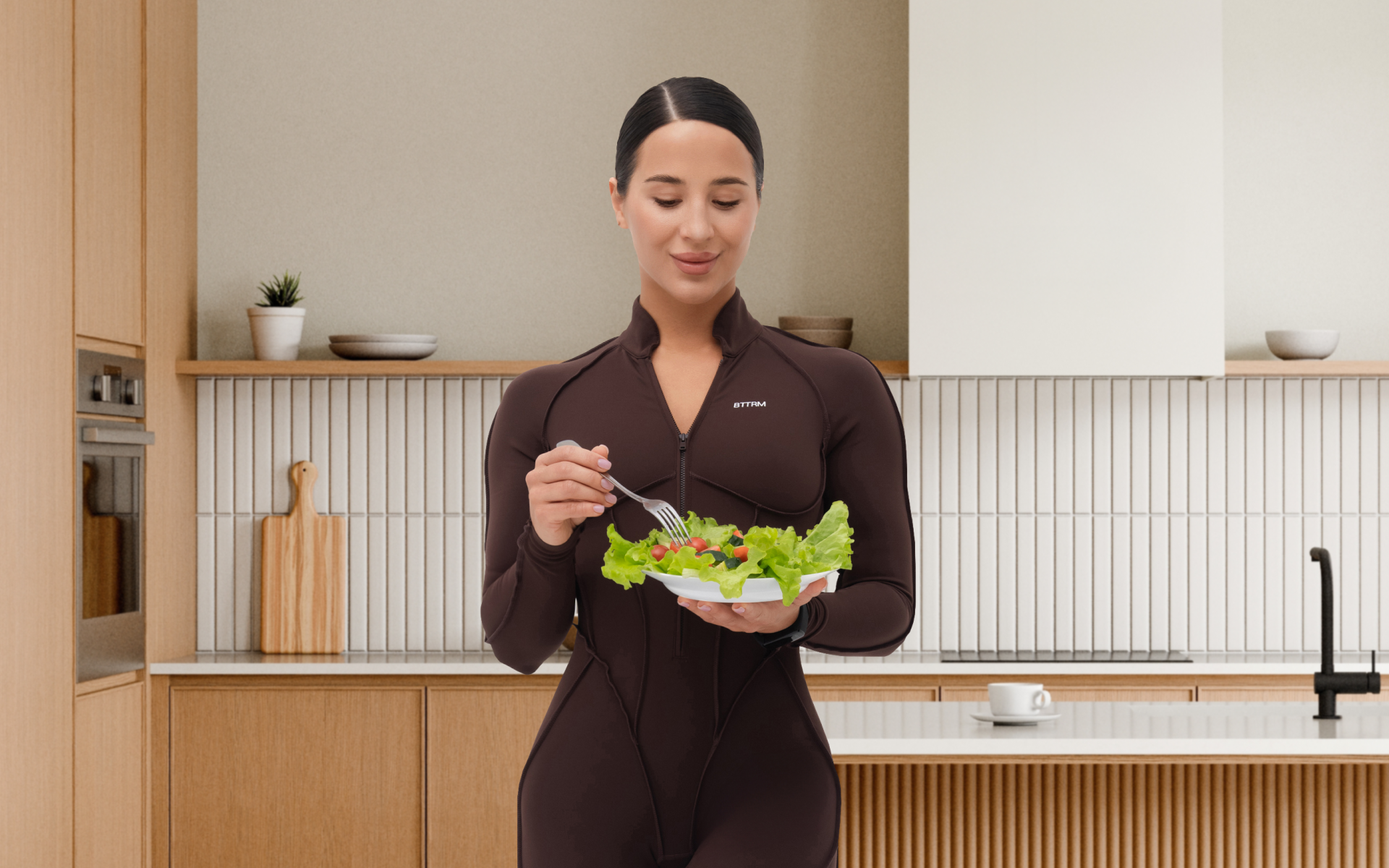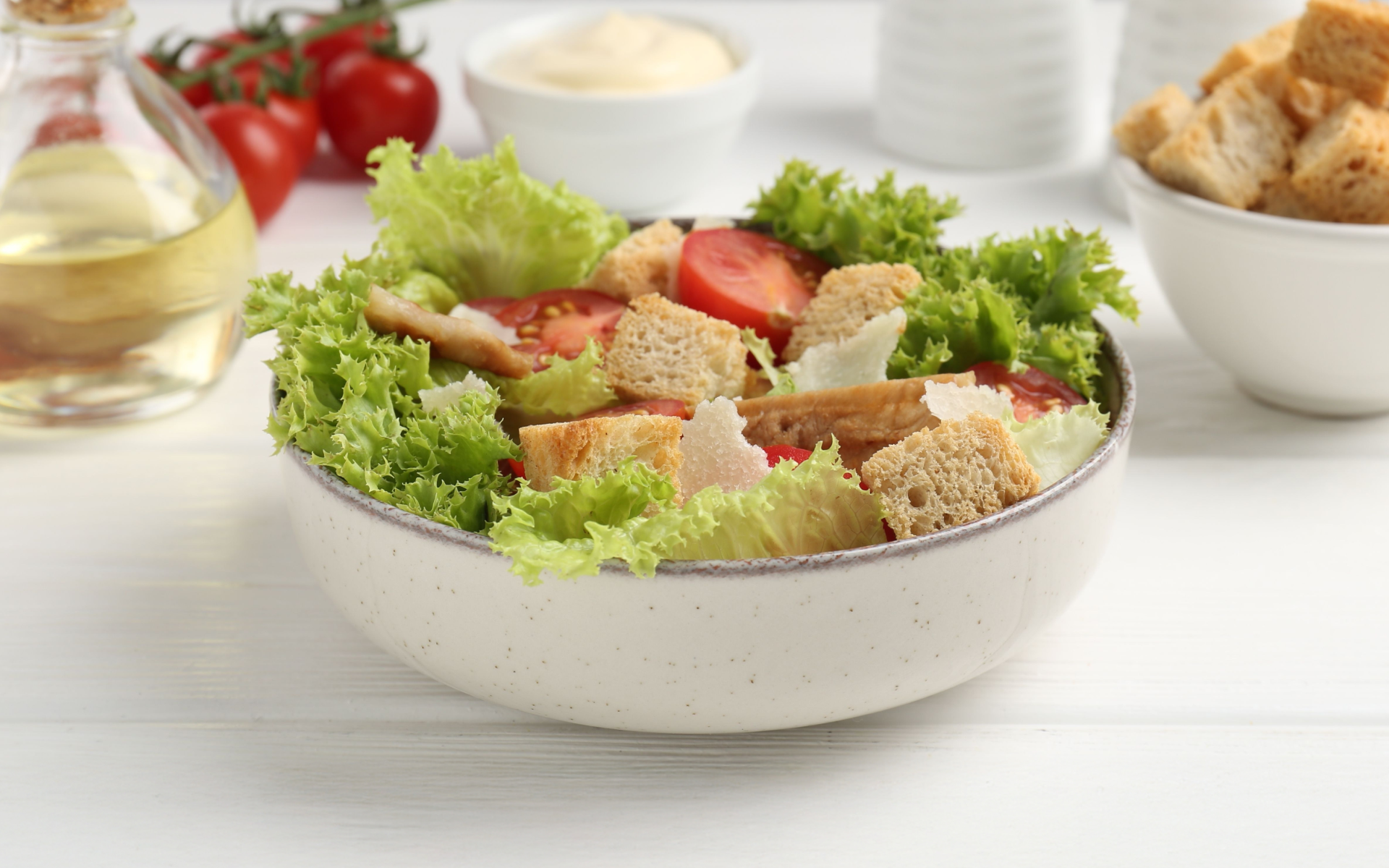What Is A 30-Day Healthy Meal Plan To Lose Weight?
A 30-day healthy meal plan to lose weight is a structured yet flexible guide that can help you eat more mindfully over a month, with the primary goal of achieving gradual and sustainable fat loss.
Unlike crash diets or “detoxes” that rely on extreme restrictions, this monthly healthy meal plan to lose weight focuses on:
- Adding more wholesome and nutrient-rich foods to your meals
- Building healthier eating habits that can last for a long time
- Being mindful about portion control
All of this to support not only weight loss but also overall physical and mental well-being.
So, rather than cutting back on entire food groups or following unsustainable rules, a well-designed healthy meal plan will focus on including nutritious, minimally processed foods that nourish your body and promote long-term healthy habits.
This eating pattern may also help promote healthy digestion, stable blood sugar levels, improved energy, and even better mood and sleep quality (1).
Why Follow A 30-Day Plan?
One of the main benefits of following a 30-day plan is that it provides structure and eliminates the guesswork that can occur with meal planning. And you’re not alone on this aspect; it happens to many people.
When we dedicate a bit of time to plan our meals and snacks, we’re less likely to make impulsive food choices or turn to convenient yet less nutritious options.
For many people, fatigue, lack of time, and emotional eating are barriers to eating well. However, with a meal plan, they can address those challenges by having more predictability, routine, and clarity.
Additionally, by committing to a 30-day timeframe, you give your body and mind the opportunity to adapt to new habits. Research suggests it can take anywhere from 21 to 66 days to form a new habit, depending on the behavior and the person (2).
A 30-day window strikes a practical balance between introducing healthier routines and avoiding burnout.
When it comes to weight loss, progress is made by inches, not miles, so it’s much harder to track and a lot easier to give up. The BetterMe: Health Coaching app is your personal trainer, nutritionist, and support system all in one. Start using our app to stay on track and hold yourself accountable!
What Should I Eat On A 30-Day Healthy Diet?
While our nutritional needs may vary, the foundation of a healthy 30-day plan should include a variety of nutritious, minimally processed foods, with the goal of eating three balanced meals a day and one or two snacks as needed.
However, the number of meals you may need can vary, so it’s essential to find the balance that works for you (3)
A high-quality 30-day weight loss plan should keep in mind the following key aspects:
- Balanced Macronutrients
Our body needs a proper balance of the three macronutrients—carbohydrates, protein, and fats—to function optimally. Each of these macronutrients has specific and vital roles, which extend far beyond simply counting calories.
Our target caloric intake and macronutrient balance may vary depending on factors such as weight, height, age, and level of physical activity. You can find out what’s right for you here.
A good meal plan prioritizes quality sources of each:
- Carbohydrates: Often misunderstood, carbs are our body’s preferred energy source. Complex carbs like whole grains, including quinoa, oats, brown rice, whole wheat products; starchy veggies such as sweet potatoes, and corn; pulses like lentils, beans, and chickpeas; and all fruits offer fiber, crucial for satiety and appetite control (4).
Unlike refined carbs, such as white bread, candy, or pastries, your body slowly absorbs the glucose from complex carbs by our digestive system, thanks to their fiber content, thereby avoiding energy crashes or blood sugar spikes.
Eating complex carbs with protein and healthy fat helps slow down digestion and absorption as well.
- Proteins: Essential for maintaining and repairing body tissues, proteins also help regulate appetite and preserve lean muscle during weight loss.
Protein is one of the most satiating nutrients, alongside fiber. We also require more energy to digest protein compared to carbohydrates and fats (5). The additional energy requirement means the body burns more calories digesting protein, making it a win-win situation.
Ideally, opt for lean protein sources such as skinless turkey and chicken (preferably breast), fish, eggs, tofu, tempeh, legumes, and low-fat dairy products.
You can also occasionally include lean cuts of beef and pork.
It’s worth noting that protein should be part of every meal to help boost satiety and improve metabolic health. If you can’t add much protein in one meal, be mindful about trying to add a bit more in the next one. Each meal can be an excellent opportunity to support your health.
- Fats: Unlike what many people think, fats are vital for hormone production, brain health, and nutrient absorption (especially fat-soluble vitamins A, D, E, and K).
However, the benefits exist in healthy unsaturated fats, such as those found in avocados, olive oil, vegetable oil, nuts, seeds, and fatty fish like salmon or mackerel.
Try to avoid trans fats and minimize saturated fats from fatty meats and ultra-processed foods (6). For more details about the whole food meal plan, take a look at our prior publication.
Read more: Foods That Increase Metabolism And Burn Fat
How To Build A Balanced Meal
A general rule is to aim for meals that include all three macronutrients.
For example:
- Scrambled eggs with spinach, avocado, and whole-grain toast for breakfast.
- Grilled chicken breast, roasted sweet potatoes, and a green salad with olive oil dressing for lunch.
- Baked salmon, quinoa, and steamed broccoli for dinner.
Adequate Micronutrients
Micronutrients, including vitamins and minerals, play numerous roles in the body, from supporting the immune system to aiding metabolism and protecting against chronic diseases (7). The key to a well-balanced diet rich in vitamins and minerals is always to eat a variety of foods from the rainbow.
What does this mean?
Always striving for a colorful diet, mixing different types and colors of veggies, fruits, meats, seeds, and nuts.
For example:
- Vitamin C: Citrus fruits, bell peppers, and strawberries. Help support our immune health and skin repair.
- Iron: Red meat, spinach, legumes. Helps transport oxygen in the blood.
- Calcium: Dairy, fortified plant milks, leafy greens. Supports bone health.
- Magnesium: Nuts, seeds, and whole grains. Aids in muscle function and sleep.
Flexibility and Variety
Rigid meal plans are challenging to adhere to in the long term. For example, many wonder, “Will I lose weight if I eat one meal a day for a month?”
Diets like “one meal a day” tend to lead to frustration, boredom, unnecessary guilt, and binge eating habits, which is why flexibility and variety are key aspects for a sustainable 30-day plan.
This flexible aspect allows room for swapping ingredients based on preferences or availability, listening to your body’s hunger cues and cravings, and enjoying a mix of sweet and savory dishes, warm and cold meals, and different cuisines.
Flexibility also makes it easier to dine out, attend social events, or handle busy days without completely abandoning your goals.
Portion Awareness
You don’t need to count every calorie to have a successful weight loss journey.
However, being aware of portion control is key to helping you reach your goals.
This “control” is not about restriction, but instead listening to your body’s needs and learning to estimate portions that work to keep you full while still helping you shed some pounds.
Some visual cues can make healthy eating feel more natural and intuitive. For example:
- Protein: The size of your palm
- Carbohydrates (grains/starches): The size of your fist
- Fats: The size of your thumb or one tablespoon
- Vegetables: As many as two open hands
Moreover, incorporating mindful eating techniques, such as eating slowly, avoiding distractions, and stopping when full, can also be great tools to help regulate intake naturally.
The BetterMe: Health Coaching app will provide you with a host of fat-frying fitness routines that’ll scare the extra pounds away and turn your body into a masterpiece! Get your life moving in the right direction with BetterMe!
Meal Planning and Preparation
Another essential part of a 30-day plan, often misunderstood, is meal prepping and grocery planning. While some may feel overwhelmed by the idea of meal prepping, it can become a simple strategy to incorporate that makes sticking to healthier eating habits much easier.
Simply setting aside some time to prepare meals or ready-to-eat ingredients can make it easier to stick to your goals, reduce food waste, and avoid last-minute unhealthy choices.
You can slowly try to incorporate:
- Batch cooking proteins like grilled chicken, roasted tofu, and hard-boiled eggs. Protein helps support muscle repair and keeps you full.
- Chopping, washing vegetables, and oven roasting in advance. Aim for a colorful variety to get a range of nutrients and antioxidants.
- Cooking grains like rice or quinoa for easy meal assembly. They offer fiber and sustained energy.
- Portioning snacks like hummus and veggie sticks, yogurt with seeds, or trail mix
Read more: Foods to Cut Out to Lose Weight In a Sustainable Way
How Can I Make A 30-Day Healthy Meal Plan?
To help you create your own personalized 30-day healthy meal, here are some key steps to keep in mind:
Assess Your Goals: Depending on your weight loss goals, age, sex, and activity level, you can determine your ideal daily calorie intake.
According to the Dietary Guidelines for Americans, adults should consume a daily caloric intake of between 1,600 and 3,000 calories. However, please note that this is general guidance.
Knowing what our individual calorie needs, or Total Daily Energy Expenditure (TDEE), is vital to achieve our weight loss goals effectively. A simple method to estimate our TDEE is using the Mifflin-St.. Jeor equation, either by hand or with online calculators.
Plan Weekly: Once you have your calorie intake goal, break the month into four weeks and plan 5–7 days of meals at a time. This planning process can help you get organized with grocery shopping and separate the time you’ll need to prep these foods. Additionally, having a plan in mind can help you stay calm as you navigate your weight loss journey.
Stock Your Kitchen & Pantry: Once you have your weekly plan written, you can plan your grocery shopping around those options and what you already have at home.
What Is Important To Include In A 30 Day Healthy Meal Plan?
A good foundation of basic ingredients to help you cook from scratch can include the following options:
- Milk
- Eggs
- Rice
- Oats
- Pasta
- Quinoa
- Low-fat yogurt
- Olive or vegetable oils
- Lean meats, poultry, and fish
- Canned and dried beans
- Fresh, frozen, or canned veggies and fruits
Feel free to plan around what you like and what is easily accessible to you.
Choose Recipes: Having an idea of what to cook is great, but sometimes, having a detailed recipe can be even easier to follow through with.
Healthy meals for weight loss on a budget get easier when you search and save recipes to your phone or computer. And we have tons of options in our Blog for you!
What Results Can I Expect From A 30-Day Healthy Meal Plan?
While weight loss is usually the primary goal, following a healthy meal plan can have far-reaching effects that extend beyond simply shedding a few pounds.
This lifestyle change helps promote healthier eating habits that last for longer and could also lead to (8):
- Better digestion and less bloating
- Reduced sugar cravings
- Improved energy levels
- Better mood and focus
- Enhanced sleep quality
- Clearer skin
However, it’s worth noting that these results depend on individual consistency and lifestyle factors, which may vary from one person to another. Apart from diet and exercise, other factors to consider include genetics, stress, and sleep.
For the best results, integrating a healthy 30-day meal plan for weight loss with regular exercise, mindfulness, and adequate rest is the most effective combination for success.
Consult with a healthcare professional, such as a dietitian, for personalized advice tailored to your specific needs and situation.
How Much Weight Can I Lose In 30 Days Of A Healthy Diet?
While it’s true that a healthy eating plan can aid in weight loss, there’s no exact number we can estimate here. Weight loss is a complex process, not solely restricted to what we eat. It can vary significantly depending on starting weight, activity level, metabolic rate, and adherence to the plan.
On average, a healthy and sustainable weight loss goal is 1 to 2 pounds per week, resulting in approximately 4 to 8 pounds over a 30-day period.
Yet, those who have more weight to lose may see more significant changes initially due to water weight and reduced bloating from dietary changes. You may then notice a weight loss plateau, a common occurrence. However, it’s crucial to maintain healthier habits and exercise to help move past this state with consistency as your lifeline (9).
While some people may think crash diets are the best way, as they promise faster results, this excessive restriction often leads to muscle loss, nutrient deficiencies, and weight regain.
Thus, a 30-day healthy plan or 1 month meal plan focusing on long-term results and encouraging steady progress through balanced nutrition, regular meals, and physical activity can be a good strategy for many people looking to lose weight.
For most people, eating approximately one egg per day is considered safe and healthy. Eggs are an excellent source of high-quality protein and essential micronutrients, including choline, iron, and vitamin D. If you have high cholesterol or other medical conditions, it is best to consult with your doctor or a dietitian to determine if consuming one egg per day is the best option for you. This duration depends on the type of meal prepping you’re doing, in particular. For example, we must consume fresh foods within 3–5 days; however, you can easily batch-cook and freeze meals in advance for added convenience. Proper storage, labeling, and freezing methods make it possible to prep for up to a month. Use freezer-safe containers and rotate your stock. On average, an adult consumes approximately 2,000 to 2,500 calories per day, totaling 60,000 to 75,000 calories per month. This calorie amount translates to approximately 90 meals and 60 snacks over a 30-day period. Some key aspects to help you meal plan for a month include choosing 10–15 favorite meals to rotate, having a master grocery list, shopping weekly or bi-weekly, batch cooking and freezing staples (grains, soups, proteins), You can also use a calendar or app to schedule meals and prep times.Frequently Asked Questions
Is it healthy to eat eggs every day?
Can meal prep last a month?
How much does one person eat in a month?
How to meal plan for a whole month?
The Bottom Line
A 30-day monthly healthy meal plan for weight loss can be a practical and empowering tool for individuals seeking to enhance their eating habits and achieve their body goals without resorting to restrictive or unsustainable methods.
By focusing on nutritious, minimally processed foods, this plan can help you build a deeper connection with your food and your overall health.
A meal plan can also help with added structure and routine, potentially reducing decision fatigue and making healthy choices more convenient and enjoyable.
However, it’s essential to remember that no one-size-fits-all approach exists when it comes to health and nutrition. We designed this guide for general knowledge, offering practical strategies to help you get started.
Personal needs may vary based on medical history, lifestyle, and preferences, so consulting a registered dietitian or qualified healthcare provider is highly recommended.
DISCLAIMER:
This article is intended for general informational purposes only and does not serve to address individual circumstances. It is not a substitute for professional advice or help and should not be relied on for making any kind of decision-making. Any action taken as a direct or indirect result of the information in this article is entirely at your own risk and is your sole responsibility.
BetterMe, its content staff, and its medical advisors accept no responsibility for inaccuracies, errors, misstatements, inconsistencies, or omissions and specifically disclaim any liability, loss or risk, personal, professional or otherwise, which may be incurred as a consequence, directly or indirectly, of the use and/or application of any content.
You should always seek the advice of your physician or other qualified health provider with any questions you may have regarding a medical condition or your specific situation. Never disregard professional medical advice or delay seeking it because of BetterMe content. If you suspect or think you may have a medical emergency, call your doctor.
SOURCES:
- Healthy Eating Plate (n.d, nutritionsource.hsph.harvard.edu)
- Making health habitual: the psychology of ‘habit-formation’ and general practice (2012, pmc.ncbi.nlm.nih.gov)
- The Influence of Meal Frequency and Timing on Health in Humans: The Role of Fasting (2019, pmc.ncbi.nlm.nih.gov)
- Physiology, Carbohydrates (n.d, ncbi.nlm.nih.gov)
- Physiology, Proteins (n.d, ncbi.nlm.nih.gov)
- Biochemistry, Lipids (n.d, ncbi.nlm.nih.gov)
- Nutrition: Micronutrient Intake, Imbalances, and Interventions (n.d, ncbi.nlm.nih.gov)
- Diets for Health: Goals and Guidelines (2018, aafp.org)
- Steps for Losing Weight (n.d, cdc.gov)

